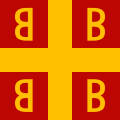More languages
More actions
| Roman Empire Βασιλεία Ῥωμαίων Imperium Romanum | |
|---|---|
| 395–1453 | |
|
Flag | |
 Byzantium at its maximum extent in 555CE | |
| Capital | Constantinople |
| Common languages | Greek |
| Dominant mode of production | Feudalism |
| Government | Absolute monarchy |
| History | |
• Formation of the Roman Empire | 27 BCE |
• Change of the capital from Rome to Constantinople | 330 |
• Final division of the Roman Empire | 395 |
• Constantinople falls; Byzantium ends | 1453 |
| Population | |
• 565 CE estimate | ~26,000,000 |
The Empire of the Romans (Greek: Βασιλεία Ῥωμαίων, Vasileía Romaíon) or Eastern Roman Empire, commonly called the Byzantine Empire or Byzantium, was Greco-Roman state that lasted from 395 to 1453 CE. It is commonly viewed as a medieval continuation of the Roman Empire. At its foundation, the Byzantine Empire controlled one-third of the Roman army but collected two-thirds of its tax revenue. Its well-equipped, professional armies were able to defeat repeated invasions while the western empire collapsed into a patchwork of warring states.[1]
Byzantium's conservative ruling class prevented technological advancement and relied on knowledge dating to the Roman era in the fields of architecture, metallurgy, and military strategy.[2]
Nomenclature[edit | edit source]
The term "Byzantine Empire" is a modern term that the state's inhabitants did not use. The term "Byzantine" comes from Byzantium, an older name for Constantinople, the empire's capital city.[3] The empire's inhabitants simply would have called themselves "Romans," seeing continuity between their state and the more ancient, Latin-speaking empire. The name they used for their state was "Empire of the Romans."[4] The name "Eastern Roman Empire" is used by modern academics to avoid relying on modern constructs without causing confusion with the ancient Roman Empire.[3]
History[edit | edit source]
Pre-Division[edit | edit source]
In 324, construction of Constantinople started under Roman emperor Constantine I. In 330, Constantinople became the capital of the Roman Empire.
Early history[edit | edit source]
Early Byzantine emperors were able to keep control of the Balkans, Syria, Anatolia, and Egypt. Barely 50 years after Justinian's last attempt to conquer the west, Byzantium lost economic control of its outer territories and reoriented its economy around defense.[2]
Stagnation and decline[edit | edit source]
The Arabs took control of Syria in 636 at the Battle of Yarmuk and would conquer the wealthy grain-producing regions of Egypt and North Africa in the following decades. When the Turks seized eastern Anatolia in 1071, the empire shrank to half its territory during 1025. Crusaders sacked the capital city of Constantinople in 1204 during the Fourth Crusade, establishing the Latin Empire. Although the Byzantine rump-state of Nicaea would restore the empire in 1261, the Byzantines were never able to fully recover and the remnants of the empire finally fell to the Ottomans in 1453.[1]
Economy[edit | edit source]
Although the empire was well-developed and wealthy compared to surrounding states, its extensive imperial bureaucracy prevented the growth of a strong mercantile class allowing for Western merchants to eventually gain large amounts of economic influence.[2]
Culture and society[edit | edit source]
Religion[edit | edit source]
Byzantine authorities persecuted pagans, Jews, and non-Orthodox Christians, who together made up almost half of the total population.[2]
References[edit | edit source]
- ↑ 1.0 1.1 Neil Faulkner (2013). A Marxist History of the World: From Neanderthals to Neoliberals: 'European Feudalism' (p. 79). [PDF] Pluto Press. ISBN 9781849648639 [LG]
- ↑ 2.0 2.1 2.2 2.3 Chris Harman (1999). A People's History of the World: 'The ‘Middle Ages’' (pp. 117–120). [PDF] London: Bookmarks Publications Ltd. ISBN 9781898876557 [LG]
- ↑ 3.0 3.1 “The term 'Byzantine' derives from Byzantium, the name of the city founded in the eighth century BCE that had previously occupied the site of Constantine's Constantinople, and is a modern construct first used in seventeenth-century Europe. 'Byzantium' and 'Byzantine' are now used freely to refer to all aspects of the East Roman Empire and its culture. As an extension of the Roman Empire Byzantium's structures of government and administration evolved seamlessly from those of the late Roman empire of the first centuries CE, with Latin initially the language of administration. The language of its literary culture, however, was Greek. From its inception Constantinople was a Christian city, whose bishop in time became the ecumenical patriarch of the Orthodox Church while the rituals and thought patterns of Christianity became all pervasive in the Byzantine way of life. The defining characteristics of this empire are thus that it was Roman in law and government, Greek in language and literary culture, and Christian in its religion.”
Robin Cormack, John F. Haldon & Elizabeth Jeffreys (2008). The Oxford Handbook Of Byzantine Studies: 'Byzantine Studies as an academic discipline' (p. 4). [PDF] Oxford University Press. - ↑ Great Soviet Encyclopedia (3rd ed.), vol. 5: 'Byzantine Empire' (1971) (Russian: Boljšaja sovjetskaja enciklopjedija). [PDF] Moscow.

